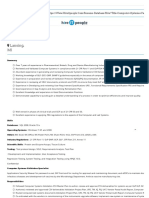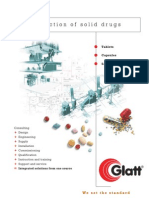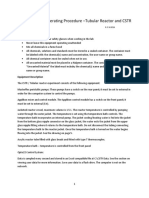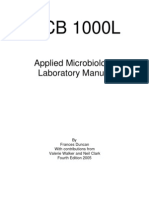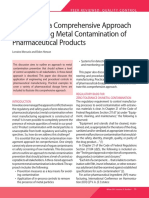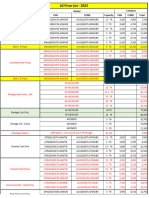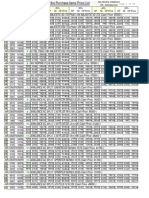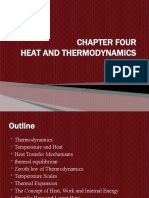Val - WhitePaper - Warehouse-temperature-Mapping v.4
Val - WhitePaper - Warehouse-temperature-Mapping v.4
Uploaded by
Azeddine LACopyright:
Available Formats
Val - WhitePaper - Warehouse-temperature-Mapping v.4
Val - WhitePaper - Warehouse-temperature-Mapping v.4
Uploaded by
Azeddine LAOriginal Title
Copyright
Available Formats
Share this document
Did you find this document useful?
Is this content inappropriate?
Copyright:
Available Formats
Val - WhitePaper - Warehouse-temperature-Mapping v.4
Val - WhitePaper - Warehouse-temperature-Mapping v.4
Uploaded by
Azeddine LACopyright:
Available Formats
Planning a Successful
Warehouse Mapping Study
asy
SM
Author: Alex Debreceni
BioServices
The Importance of
Thermal Mapping
Pharmaceutical, biological and medical device products require controlled environmental storage conditions.
Degradation can occur when the storage environment of the product exceeds the range of safe conditions
of the product. For example, some pharmaceutical materials need to be stored at ambient temperature to
preserve the potency of the product. If the temperature of the storage environment goes outside that range,
damage to the pharmaceutical material may occur. Thermal mapping of all storage areas is required to assess
the environmental conditions stored pharmaceutical materials will be exposed to. This is especially true of
warehouse storage due to large seasonal variations of environmental conditions.
Create a Plan
A critical step when temperature mapping
warehouses is to determine the scope of the
project. A number of factors must be considered
when determining the scope; the number of
mapping studies, study length, the temperature
range acceptable for operation, quantity of sensors,
sensor locations, storage envelope parameters,
and any other information deemed important by
the end user, all are critical pieces of information
to ensure a successful mapping study whereas
the storage envelope refers to a specific section
of the warehouse designated for product storage. the winter months. This is due to the greater
Parameters relevant to the storage envelope include temperature difference between the outside and
storage rack numbers, storage rack dimensions, inside conditions of the warehouse. Warehouses
storage rack and product spacing, and thermal mass located in colder environments will most likely
distribution. require more HVAC power in the colder months for
the same reason. This will be true for most ambient
Information about the geographic location of storage areas, as they are temperature controlled
the warehouse or storage area is necessary for by facility HVAC systems. Airflow in storage areas
planning a mapping study. For example, warehouses is extremely important for temperature regulation.
located in a tropical environment will require more If air is not properly circulated throughout the
HVAC power to maintain ambient temperature storage area, a stratification effect can occur.
and humidity during the summer months than This means there will be a distinct temperature
2 ©2019 Masy Bioservices | (978) 433-6279 | www.masy.com
gradient, with temperatures increasing from the
floor of the area to the roof. Warm air will become
stagnant on the upper levels of the storage space
during the summer months. Thermal conduction or previously qualified where the ”As-Is” loaded
through the walls of the warehouse will transfer condition is identified and documented with
heat to any product stored up against it. The walls respect to current load.
will also allow for the transfer of heat through
convection and conduction throughout the Temperature mapping studies need to capture
warehouse. normal operation of the storage area as well
as low foot traffic days to get the full range of
Seasonal temperature swings will greatly affect the temperature variations. Temperature excursions
operation of the HVAC systems in place to regulate can occur during normal operation events such
the temperature of the storage environment. It as opening a door, excessive foot traffic, product
is required by the United States Pharmacopeia, movement, and daily HVAC operation. For these
Article 36, Chapter 1079, to perform two mapping reasons, warehouse mapping studies are run for
studies; one in the winter, and one in the summer a minimum of 7 consecutive days to demonstrate
to capture warehouse environmental data for the area uniformity during both weekdays and
most extreme outdoor low and high temperatures. weekends.
Studies are usually performed under “As-Is”
conditions for warehouses already in operation
Fig. 1: This graph
represents a Summer
profile, 7 day thermal
mapping study shown in
Fahrenheit. Sensor 36
was located outside of the
warehouse where it was
exposed to the extreme
seasonal temperatures.
©2019 Masy Bioservices | (978) 433-6279 | www.masy.com 3
Executing the Plan
Temperature ranges in the warehouse are
defined with respect to the product in storage
and the ability of the environmental control
system to maintain the proper conditions.
From this information, acceptance criteria for
a passing mapping study can be determined.
Mapping studies can also be performed to
determine that the area mapped is suitable
for a specific pharmaceutical material that
requires a certain temperature and humidity
range. For ambient temperature storage, a
range of 15°C to 30°C is acceptable with
brief excursions due to outside environmental
variation.
Sensor locations and quantity will depend
greatly on the size and shape of the storage
area. Three sensors should be placed on
all corners of the storage area, one at the
top of the storage space, one in the middle
of the storage space, one at the bottom Sensors should be labeled with unique
of the storage space. Three sensors should identifiers to mark their location. A map
also be placed in the center of the area with sensor locations allows anyone to easily
and individual sensors should be placed determine locations of hot and cold areas
next to all monitoring probes, thermostats, in the warehouse. Well-documented sensor
entrances, or any other sources that influence placement allows for consistency in each of
temperature. It may also be beneficial to the seasonal mapping studies. Dataloggers
place sensors in storage rack areas to capture used for data acquisition must be calibrated
temperature conditions next to product. An and traceable to NIST or equivalent followed
additional sensor should be placed in an area by a calibration-verification after the
representative of outside temperature and qualification. This ensures the dataloggers
humidity for reference purposes only. This remained accurate within the application
is done to capture the outdoor temperature temperature range throughout the data
and humidity conditions the warehouse will collection process. Sensors should be secured
experience throughout the mapping study. to their locations for the entirety of the study.
4 ©2019 Masy Bioservices | (978) 433-6279 | www.masy.com
Analyzing the Results
After the mapping has ended, the data is
analyzed. Results from the mapping study
should be compared to the acceptance
criteria defined by the end user. In order
for the warehouse to pass the qualification,
the minimum and maximum temperatures
during the study must be within the specified
operating range. The humidity readings are
typically recorded and utilized as a reference
only. Because all of the sensors and locations
are labeled, the minimum and maximum
temperatures recorded will identify the coldest
and the warmest locations in the warehouse
as well as any non-conforming areas that fall
outside of the specified operating range. With
that information the end user can make key
decisions with regards to product storage. The Mean Kinetic Temperature
One way to eliminate non-conforming areas is defined as:
is to demarcate those as outside the range, if
any are identified. Monitoring sensors can be TK is the mean kinetic temperature in kelvin;
placed in locations that challenge the limits ΔH is the activation energy in kJ, R is the
universal gas constant, n is the number of
of the operating ranges so those areas are
sample events, when the samples are taken
constantly monitored and can be addressed
after the same time period, and Tn is the
if an excursion occurs. The maximum and
temperature taken at a sample point n in
minimum temperature locations may vary
kelvin. This equation weighs each data point
depending on season, so monitoring systems
against all of the other data points taken in
sensor placement should account for seasonal
a study, so small excursions from the normal
extremes. operation of the storage area, such as product
loading or movement, and door openings, will
Another key tool used to analyze data for not have a great effect on the calculation of
warehouse mapping is the Mean Kinetic the mean temperature of a specific location
Temperature (MKT). The MKT can be used to of the storage space.
evaluate readings from a single datalogger if
the temperature profile fluctuates in a distinct
pattern, such as a sinusoidal wave with
repeating temperature peaks and dips. The MKT
will give an accurate mean temperature for a
datalogger that experiences short excursions.
©2019 Masy Bioservices | (978) 433-6279 | www.masy.com 5
Conclusion
Pharmaceutical materials require controlled
environmental storage conditions to preserve
and protect the efficacy of the product.
Thermal mapping of warehouse storage areas
is essential to assess the environmental
conditions the products will experience.
Certain considerations need to be made prior
to the mapping study. Mapping studies should Citations
be planned to capture seasonal temperature
extremes and daily operations the storage area USP-NF. Good Storage and Distribution for Drug
can experience. Sensors should be placed in Products. USP 36 General Information / Good Storage and
Shipping Practices. Retrieved September 14, 2018
locations to identify at risk temperature areas
during mapping. Data collected through the
study should be analyzed and compared to the
acceptance criteria. Warehouse storage is a key
step in many pharmaceutical product life cycles.
Understanding all stages of the process is
essential in successful pharmaceutical storage.
Learn more at www.masy.com
6 ©2019 Masy Bioservices | (978) 433-6279 | www.masy.com
You might also like
- Pda TR70 2015Document75 pagesPda TR70 2015ammaostsNo ratings yet
- AIR HANDLING SYSTM IN PHARMACEUTICAL MANUFACTURING - Pharm R.A. BinitieDocument86 pagesAIR HANDLING SYSTM IN PHARMACEUTICAL MANUFACTURING - Pharm R.A. BinitieDinesh babuNo ratings yet
- Manual V100-V30-70 ENGDocument38 pagesManual V100-V30-70 ENGAzeddine LANo ratings yet
- SOP For Analytical Method ValidationDocument41 pagesSOP For Analytical Method ValidationPravin GaIkwadNo ratings yet
- MINITAB User's Guide Chap - 11Document32 pagesMINITAB User's Guide Chap - 11Ernesto Neri100% (3)
- Stability Q ADocument16 pagesStability Q Amaneshdixit4312No ratings yet
- GAMP5 Process Control System ValidationDocument1 pageGAMP5 Process Control System Validationkrisna8154No ratings yet
- Computer Systems Validation Specialist Resume Profile, Lansing, MI - Hire IT People - We Get IT DoneDocument6 pagesComputer Systems Validation Specialist Resume Profile, Lansing, MI - Hire IT People - We Get IT DoneSenthil NathanNo ratings yet
- ChemDraw TrainingDocument64 pagesChemDraw Trainingslash_de_law7484No ratings yet
- ACTD On QualityDocument21 pagesACTD On QualityDrSyeda RimaNo ratings yet
- ACTD PartIVClinical Nov05Document50 pagesACTD PartIVClinical Nov05TueNo ratings yet
- Vaisala Mapping Made Easy Presentation 0Document43 pagesVaisala Mapping Made Easy Presentation 0LeonardoNo ratings yet
- DAX Functions List Quick ReferenceDocument29 pagesDAX Functions List Quick Referencepedro 2009No ratings yet
- (NORMA) Request For Quality MetricsDocument14 pages(NORMA) Request For Quality MetricsJhovanaNo ratings yet
- Glatt Production of Solid DrugsDocument16 pagesGlatt Production of Solid Drugsteatoom100% (4)
- Validation Part2Document48 pagesValidation Part2gvasNo ratings yet
- 9 Temperature Mapping Mistakes To AvoidDocument5 pages9 Temperature Mapping Mistakes To AvoidReema IshaqNo ratings yet
- Seizure Care ProformaDocument3 pagesSeizure Care ProformaUdhav GoenkaNo ratings yet
- 9 Steps To GMP Warehouse Mapping VaisalaDocument9 pages9 Steps To GMP Warehouse Mapping VaisalaAmol AdsulNo ratings yet
- Robust Technology Transfer EMADocument24 pagesRobust Technology Transfer EMASilke Igemann100% (1)
- QM - FDA - Request For Quality MetricsDocument31 pagesQM - FDA - Request For Quality Metricspchakravarty_2No ratings yet
- Drug Accountability - An Important Aspect of Clinical ResearchDocument15 pagesDrug Accountability - An Important Aspect of Clinical ResearchTrialJoinNo ratings yet
- GEA Drying and Particle Formation Technologies For The CHEMICAL Industry - tcm11-24003Document28 pagesGEA Drying and Particle Formation Technologies For The CHEMICAL Industry - tcm11-24003Sergio A. Rdz. F.No ratings yet
- Validation TutorialDocument20 pagesValidation TutorialbahrulNo ratings yet
- Journal of Drug Discovery and Therapeutics 1 (9) 2013, 13-19Document7 pagesJournal of Drug Discovery and Therapeutics 1 (9) 2013, 13-19anandhra2010No ratings yet
- Continuous Processing in Pharmaceutical Manufacturing: Matthew J. Mollan JR., Ph.D. and Mayur Lodaya, PH.D., Pfizer IncDocument11 pagesContinuous Processing in Pharmaceutical Manufacturing: Matthew J. Mollan JR., Ph.D. and Mayur Lodaya, PH.D., Pfizer IncAMMY THAKURNo ratings yet
- Selection of Material Handling EquipmentDocument6 pagesSelection of Material Handling EquipmentAkif ZubairNo ratings yet
- U R T System (I) : Blank TemplateDocument26 pagesU R T System (I) : Blank TemplatesakshiNo ratings yet
- Validation of HPLC Techniques For Pharmaceutical AnalysisDocument54 pagesValidation of HPLC Techniques For Pharmaceutical Analysisfatos-osmani-5248No ratings yet
- Data Integrity Background and FAQDocument4 pagesData Integrity Background and FAQMina Maher MikhailNo ratings yet
- IVT Network - Incorporate Domestic and International Regulations For Effective GMP Auditing - 2013-08-20Document3 pagesIVT Network - Incorporate Domestic and International Regulations For Effective GMP Auditing - 2013-08-20huykhiemNo ratings yet
- Navigation Search: or Is Required On Packaged Perishable FoodsDocument4 pagesNavigation Search: or Is Required On Packaged Perishable FoodsAaron Paul Hernandez OcampoNo ratings yet
- Draft Standard Operating Procedure - Tubular Reactor and CSTRDocument5 pagesDraft Standard Operating Procedure - Tubular Reactor and CSTRshivaNo ratings yet
- MCB 1000L: Applied Microbiology Laboratory ManualDocument70 pagesMCB 1000L: Applied Microbiology Laboratory Manualmahsamoradi100% (1)
- Cleanroom DesignDocument10 pagesCleanroom DesignshwampaNo ratings yet
- Preventing Metal ContaminationDocument6 pagesPreventing Metal Contaminationlouish9175841No ratings yet
- Deming PDCADocument3 pagesDeming PDCARajaram SastryNo ratings yet
- EU-GMP Chapter 5 (Production)Document7 pagesEU-GMP Chapter 5 (Production)bvsc77035No ratings yet
- Calibration and Metrology PDFDocument10 pagesCalibration and Metrology PDFMano NegraNo ratings yet
- MadgeTech Data Logger 101 GuideDocument7 pagesMadgeTech Data Logger 101 GuideËdwin Carlossma HiguëraNo ratings yet
- Mecart Brochure PDFDocument20 pagesMecart Brochure PDFShenina KnightleyNo ratings yet
- Gas Leak Alarm Systems PDFDocument87 pagesGas Leak Alarm Systems PDFAvYlashKumbharNo ratings yet
- Aspen HYSYS BrochureDocument4 pagesAspen HYSYS BrochureLuiz OviedoNo ratings yet
- 17 Questions PDFDocument19 pages17 Questions PDFmuzammil21_adNo ratings yet
- Class Notes 5 Quantification of Pharmaceutical ProductsDocument21 pagesClass Notes 5 Quantification of Pharmaceutical ProductsNdatasha PambweNo ratings yet
- White Spots On TabletsDocument6 pagesWhite Spots On Tabletsedgar palominoNo ratings yet
- Thermo King Magnum Plus Maintenance Manual (Tool Catalog-TK5955)Document264 pagesThermo King Magnum Plus Maintenance Manual (Tool Catalog-TK5955)kennykolad1No ratings yet
- TR90 Product PIPagesDocument6 pagesTR90 Product PIPagesaenylevyNo ratings yet
- Lyophilization Competence06!11!2014 Tcm11 17173Document16 pagesLyophilization Competence06!11!2014 Tcm11 17173JPensacolaNo ratings yet
- User Requirements Template RAJADocument25 pagesUser Requirements Template RAJAdrs_mdu480% (1)
- Attachment 23 Criticality Assessment v3Document3 pagesAttachment 23 Criticality Assessment v3bo.ratchadaporn100% (1)
- Guidelines For Optimum Water Consumption in Bulk Drugs Manufacturing Industry PDFDocument128 pagesGuidelines For Optimum Water Consumption in Bulk Drugs Manufacturing Industry PDFSivakumar SelvarajNo ratings yet
- Guidelines On Bacterial Endotoxins Tests Version 2.0 20.01.2023Document16 pagesGuidelines On Bacterial Endotoxins Tests Version 2.0 20.01.2023Dhananjay BalghareNo ratings yet
- Preparative Chromatography for Separation of ProteinsFrom EverandPreparative Chromatography for Separation of ProteinsArne StabyNo ratings yet
- Quality Management Systems A Complete Guide - 2021 EditionFrom EverandQuality Management Systems A Complete Guide - 2021 EditionNo ratings yet
- Temperature Mapping and Monitoring - A SummaryDocument3 pagesTemperature Mapping and Monitoring - A SummaryEduardNo ratings yet
- Ich Q9Document48 pagesIch Q9Azeddine LANo ratings yet
- CAG-014 Final 04012022 SignedDocument19 pagesCAG-014 Final 04012022 SignedAzeddine LANo ratings yet
- Biocontamination NBR PTSDocument1 pageBiocontamination NBR PTSAzeddine LANo ratings yet
- GOOD Risk Assessment of Clean Room Used in Pharmaceutical Industries in Design Manufacturing EquippingDocument7 pagesGOOD Risk Assessment of Clean Room Used in Pharmaceutical Industries in Design Manufacturing EquippingAzeddine LANo ratings yet
- C19 Sonde KIMO KI932-22-01-2019Document3 pagesC19 Sonde KIMO KI932-22-01-2019Azeddine LANo ratings yet
- Certificate of Calibration: in Conformance With ISO 21501-4 Requirements For Calibration IntervalsDocument8 pagesCertificate of Calibration: in Conformance With ISO 21501-4 Requirements For Calibration IntervalsAzeddine LANo ratings yet
- Compressed Air - The Overlooked Element of Cleanroom SpecificationsDocument5 pagesCompressed Air - The Overlooked Element of Cleanroom SpecificationsAzeddine LA100% (1)
- Temperature and Humidity Monitoring Systems For Transport OperationsDocument20 pagesTemperature and Humidity Monitoring Systems For Transport OperationsAzeddine LA100% (1)
- 271 Data Integrity in Pharma - 040218Document7 pages271 Data Integrity in Pharma - 040218Azeddine LANo ratings yet
- + IQ/OQ Protocol: Installation Qualification/ Operation QualificationDocument10 pages+ IQ/OQ Protocol: Installation Qualification/ Operation QualificationAzeddine LANo ratings yet
- 2013 01 28 TemplateDocument2 pages2013 01 28 TemplateAzeddine LANo ratings yet
- Tcont900 InstallerDocument24 pagesTcont900 Installerapi-279886039100% (2)
- 45 Perlite For Non-Evacuated CryogenicDocument2 pages45 Perlite For Non-Evacuated CryogenicAhmar Bhatti100% (1)
- I-5 - 2010 Varianta in EnglezaDocument128 pagesI-5 - 2010 Varianta in EnglezarpufitaNo ratings yet
- Thermodynamics NotesDocument18 pagesThermodynamics NotesSushil KasabNo ratings yet
- Lesson Plan Deductive Learning Electrolite Non Elektrolite SolutionDocument17 pagesLesson Plan Deductive Learning Electrolite Non Elektrolite SolutionAnis MualifahNo ratings yet
- Vapor Liquid Equilibria: A Review: ArticleDocument16 pagesVapor Liquid Equilibria: A Review: ArticleLeonardo ReyesNo ratings yet
- LG Price List 2023 - UpdatedDocument2 pagesLG Price List 2023 - UpdatedmaazwzNo ratings yet
- MM 321 Lab 4Document6 pagesMM 321 Lab 4Siddhant Vishal ChandNo ratings yet
- Cooling System of High Power Synchronous GeneratorDocument5 pagesCooling System of High Power Synchronous GeneratorLorem53100% (1)
- Fiberglas TIWA Product Data SheetDocument2 pagesFiberglas TIWA Product Data SheetRangaswamy DoraiswamyNo ratings yet
- Brayton CycleDocument9 pagesBrayton CyclevqxknpnkNo ratings yet
- Curriculum Vitae: K.YeshwanthDocument5 pagesCurriculum Vitae: K.YeshwanthShankker KumarNo ratings yet
- Thermal Insulation Market in Lebanon: Le Marché de L'isolation Thermique Au LibanDocument75 pagesThermal Insulation Market in Lebanon: Le Marché de L'isolation Thermique Au Libanroger aklNo ratings yet
- PVT AnalysisDocument41 pagesPVT AnalysisEmad Aamer100% (2)
- MT Ii - HW 1Document1 pageMT Ii - HW 1Omkar RoyNo ratings yet
- S Tudent Exploration: Energy Conversion in A SystemDocument6 pagesS Tudent Exploration: Energy Conversion in A SystemMir Mir0% (4)
- Chapter 8Document84 pagesChapter 8Hafizszul FeyzulNo ratings yet
- Ran KineDocument15 pagesRan KineSatish SaxenaNo ratings yet
- Chapter Test A: Teacher Notes and Answers 16Document6 pagesChapter Test A: Teacher Notes and Answers 16Mogtaba KassimNo ratings yet
- First Law of ThermodynamicsDocument13 pagesFirst Law of ThermodynamicsVictorNo ratings yet
- CH 8. Chemical Equilibrium (Chem +1)Document40 pagesCH 8. Chemical Equilibrium (Chem +1)Dipin Preet SinghNo ratings yet
- Thermodynamic of IC EnginesDocument16 pagesThermodynamic of IC EnginesZemariam GetuNo ratings yet
- Appendix A1-A5 GaskellDocument8 pagesAppendix A1-A5 GaskellIhlasul AmalNo ratings yet
- Transport PhenomenaDocument9 pagesTransport PhenomenadeshendrenNo ratings yet
- PriceListHirePurchase Normal28thapril2020Document68 pagesPriceListHirePurchase Normal28thapril2020kjhfjkfhgjkdfhgjdkfNo ratings yet
- Données Climatiques YAOUNDE - 220908 - 165102Document2 pagesDonnées Climatiques YAOUNDE - 220908 - 165102Michel Mix TankouNo ratings yet
- Chapter Four Heat and ThermodynamicsDocument44 pagesChapter Four Heat and ThermodynamicsmesfinNo ratings yet
- Hukum TermodinamikaDocument3 pagesHukum Termodinamikalele12No ratings yet
- SHC LabDocument1 pageSHC LabAlistair DaleyNo ratings yet
- Test 07 Energy 05dkDocument13 pagesTest 07 Energy 05dkLin Xian XingNo ratings yet









